The Ultimate Guide to Managing Warranty Returns

Believing in your products means nothing if your customers don’t believe in you.
Product warranties have become a popular method for ecommerce retailers to prove the quality of their products to their customers.
Product warranties, or product protection plans, are service contracts that protect products from certain damages or accidents.
Retailers in markets such as Jewelry, Eyewear, CBD/Vape, Health + Beauty, Home, Electronics, and Swimwear use product warranties to show their customers that they stand behind what they sell.
While warranty programs are great, having to deal with warranty requests can pose a lot of challenges to retailers.
After talking to hundreds of ecommerce merchants about warranty requests, listening to their pain points, analyzing their data, and finding a solution that will fit any retailer’s glove, we decided to take things a step further; to educate you on our findings.
The fact of the matter is there’s not much information out there on managing warranty requests. So, we created this guide to give you what you need to know.
Table of Contents
Why Warranties Have Become So Popular
So, why should you even care about warranties anyway?
With the rise of ecommerce, customers are increasingly gravitating towards brands with warranties to protect their purchases.
According to Allied Market Research, the extended warranty market is projected to be valued at $170 billion by 2027.
And that’s just extended warranties. With third-party warranties, ADH plans, and other repairment or replacement warranties, the total warranty market is worth much more.
Retailers are paying more attention to their warranty workflows because of 3 major competitive advantages:
- Attracting Life-long Customers: Warranty programs make a purchase feel secure, making consumers feel at ease about the post-purchase experience. According to Mulberry, nearly 50% of consumers are more likely to choose brands that offer protection plans. Just by having product protection, more shoppers are likely to convert to customers.
- Upgrading the Customer Experience: Your customers will naturally feel frustrated with you when requesting a warranty because it indicates a problem with the product. By following through with the promises made in your warranty policy, you ease your customers’ frustration by proving you’re dependable and that you prioritize customer satisfaction. Turning a negative experience into a positive one keeps your customers happy with your brand.
- Skyrocketing Profits: Processing warranty returns puts you back in contact with your customers. This gives you the chance to expose your customers to other products such as new releases or complementary products to their past purchases. You can use the post-purchase experience to drive sales that otherwise wouldn’t have been made, converting shoppers into repeat customers.
As an ecommerce retailer, now is the time to equip yourself with the tools you need to understand warranty workflows. Otherwise, you run the risk of getting left behind while your competitors take advantage of the opportunity.
Warranty Requests as a Return Type
Up until now, warranty requests have been considered separate from returns. But this segregation has acted as a major obstacle to the entire warranty industry.
Here’s why.
The difference between warranties and other return types comes down to the customer’s intention.
With warranty requests, the customer doesn’t want to get rid of the product. They want their problem solved.
However, managing warranty requests operationally looks the same as managing other return types. Both:
- Indicate something wrong with the product.
- Involve getting information from the customer about the original purchase,
- Require a system for reverse logistics in place (funneling the products backward through the supply chain).
Putting warranty requests in their own category forces you to have two separate systems and doubles your work.
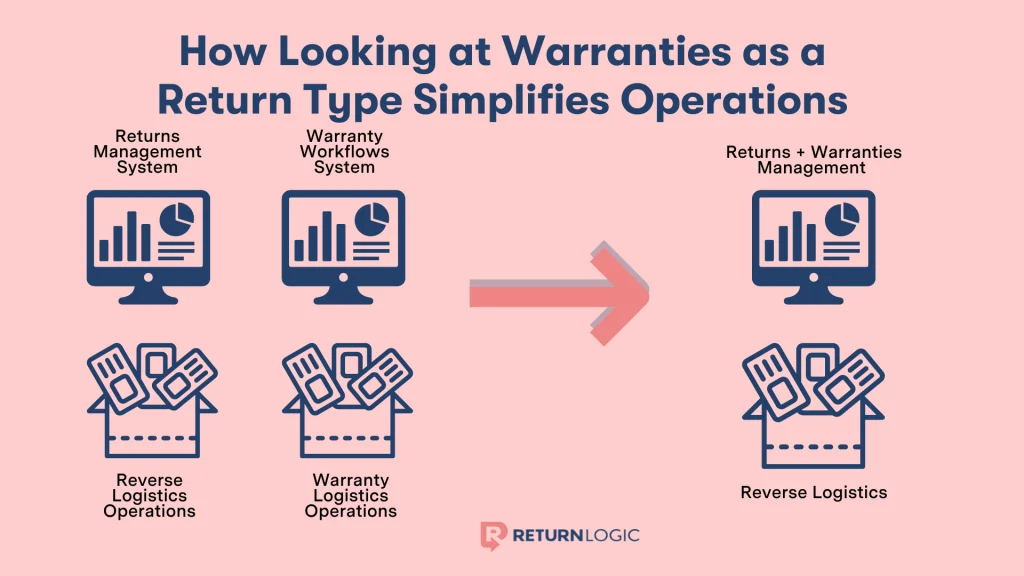
As a result, you end up with:
- 1 system for returns management to handle communication and data for all returns.
- 1 system for warranty workflows to handle communication and data for all warranties.
- 1 system of reverse logistics to manage returned products moving up the supply chain.
- 1 system of reverse logistics to manage warranty products moving up and down the supply chain.
By looking at warranties as a return type, you simplify your solutions and get:
- 1 system for returns and warranties management to handle communications and data for all returns.
- 1 system of reverse logistics to manage returned products moving up and down the supply chain.
Categorizing warranty requests as a return type makes your life as an ecommerce retailer a lot easier because you can manage everything under one system and run your business more efficiently.
A smooth backend will make your customers a lot happier.
But don’t just take our word for it. Let’s take a look at what the difference really looks like.
Warranty Requests Impact Customers’ Return Behavior
Many retailers try to avoid returns like the plague, seeing it as some sort of indication of failure.
But the truth of the matter is, the rise of ecommerce transformed returns into an expected part of the customer journey.
Instead of trying to avoid returns altogether, the question goes from:
“How do I limit the number of returns received?” to
“How do I manage my returns to increase the bottom line?”
We’ve spent years gathering data on returns behavior to answer that very question and the findings were surprising.
Some returns management software companies push exchanges as a way to limit refunds and keep sales, which intuitively makes sense.
But we’ve found that 60% of customers will still ask for a refund over an exchange, even if the option was given.
That is, unless warranties are also offered as a return type to customers. When warranty requests are added as a return option, processed refunds drop by 10%.
If you’re processing 10,000 returns a year, a 10% drop in refund rate equals roughly $50,000.

Image Source: ReturnLogic Internal Data

Image Source: Loop Returns Benchmark Report 2020
The reason for this is simple: warranties give you the chance to repair or replace whatever’s wrong with the product from your customer’s original purchase.
Your customer bought the product for a reason. Odds are, they only want to return it because something isn’t working as expected.
Your customers would rather fix that problem than give back the product if given the chance.
Not only does offering warranties as a return type decrease refunds, but increasingly more customers are asking to process a warranty when it’s offered as a return.
In the time that we’ve offered warranties as a return type, overall warranty returns have increased by nearly 2000%, totaling 500,000 processed warranty returns to date!
The proof is in the numbers.

Image Source: ReturnLogic Internal Data
These numbers showcase that offering warranty requests as a return type makes a huge impact on customers’ behavior when they’re considering returning something.
They’re more likely to get the product repaired or replaced than to just send it back and never think of your company again.
Keeping your products in the hands of your customers will increase your bottom line because:
- You’re not sending money back on a returned sale.
- You’re improving customer satisfaction and loyalty.
- You’re keeping your customers coming back for more.
In the end, not only are you keeping money in your pocket, but you’re not losing out on future customer lifetime value for customers who would’ve otherwise churned.
Benefits of Automating Your Warranty Workflows
The major benefit of offering warranties as a return type comes down to optimizing your warranty workflow.
When it comes to warranty requests, management looks the same as returns.
And just like returns, automating your process will make warranties work for you rather than becoming an obstacle in your business.
Here’s how:
- Save time and money: On average, it takes about 15 minutes to process a warranty request manually, costing $3,750 in labor costs alone for every 1,000 manually processed warranty requests. Plus, the cost per warranty only gets more expensive as you start to grow and need to hire more labor to keep up with requests. That, on top of keeping up with phone calls and emails, tracking all the data on a spreadsheet, and sending out shipping labels, a manual warranty workflow becomes a logistical nightmare.
- Enhance customer experience: Automation ensures quick invoicing to your customers. On top of that, it’ll equip your service team with all the information needed for handling a warranty request, such as order information and customer history. This keeps the customer from being bombarded with a million questions about their purchase. The quick processing with little effort leaves the customer satisfied.
- Ensure legitimate requests: Returns fraud is a big problem in ecommerce. But automating returns will allow you to get proof of purchase from your customers when processing a warranty. Fraudulent transactions will be easier to spot by asking customers for a picture of their original receipt, mitigating overall losses.
- Increase marketing lists: Processing a warranty puts you back in contact with your customer. Automating that process will keep the customer’s contact information in your CRM. Then you can add that customer into segmented email lists that give them regular updates on business initiatives that customers would be interested in. This personalizes your brand and keeps you top of mind well after the warranty return.
- Resolve returns faster: Lastly, automating your warranty processing will make resolving each warranty request exponentially quicker. You can say goodbye to the dozens of phone calls and emails per warranty return. An automated system is built to quickly move through the steps so that your time is freed up for other matters. With all this added time on your hands, imagine how far your business can grow!
When it comes to your warranties, automation is the clear answer to optimize your workflow.
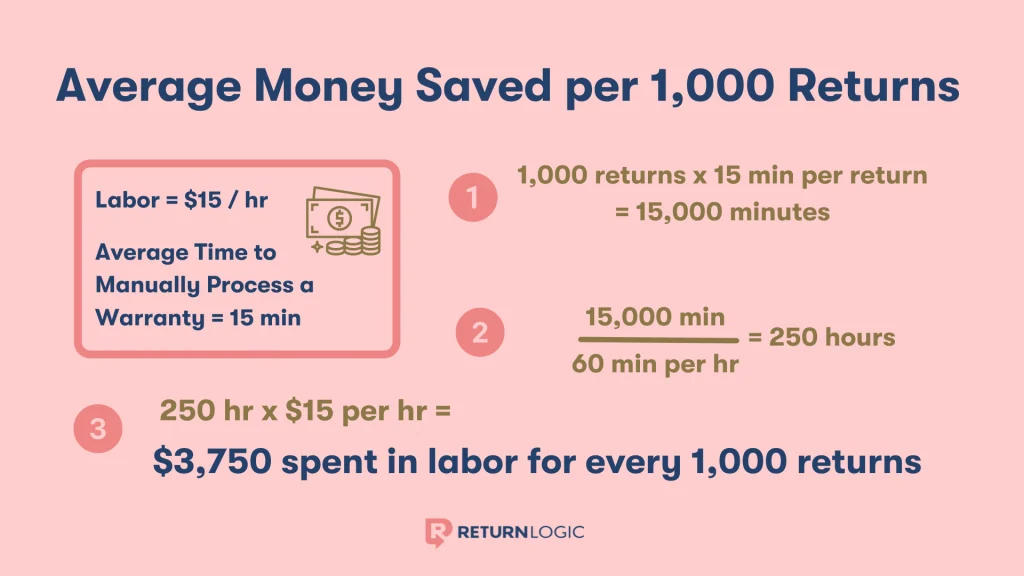
What an Automated Warranty Workflow Looks Like
Traditionally, warranties have been handled manually on paper or spreadsheets – separate from other returns because no other solution has existed.
Now, you can send customers to a branded returns portal where shoppers can choose whether they want to file a warranty claim or process a different return type.
Customers simply have to log into the returns center using their email and order number and follow through all the steps without ever needing to talk to your team.
Check out the video below to see what this experience could look like for your customers.
Automating warranties isn’t just convenient for your shoppers.
It also simplifies your workflow on the backend.
Support teams get time back by no longer having to sift through emails and phone calls to process each and every request.
Now that customers are able to go through most of the steps themselves, all that’s left is for the support team to approve or deny warranty claim requests.
They can decide to do this manually or automatically and customize what information is needed to approve a warranty request.
All of this is done under one platform so other teams are made aware of which claims are approved and denied.
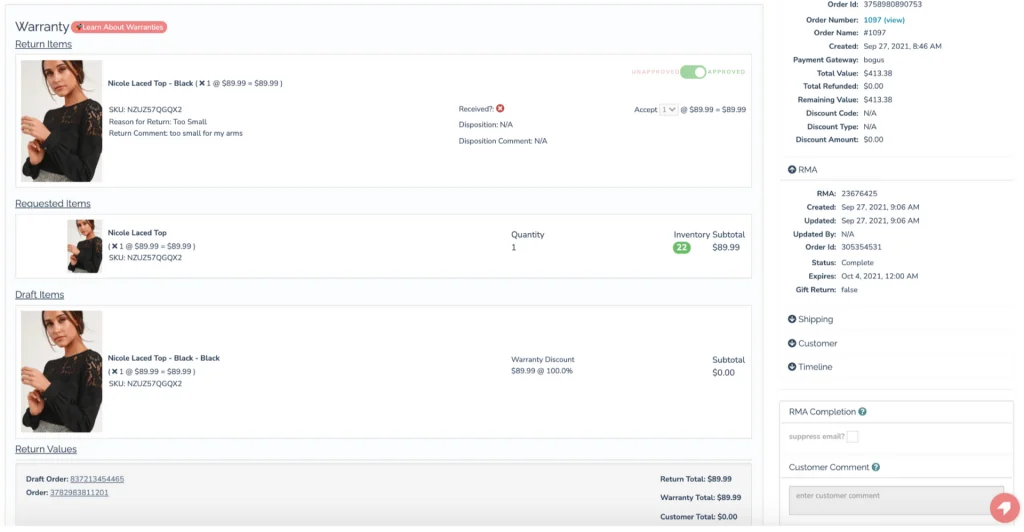
Image Source: ReturnLogic Originate
Automating warranty requests also give operations managers the flexibility to set up custom warranty request policies.
Not all warranty request policies are the same.
You may be a retailer that offers to pay for shipping while others ask the customer to cover shipping costs.
You may want your customers to add a picture of their receipt for proof of purchase and to avoid fraudulent claims.
Or you may want to automatically approve warranty claims and skip authenticating each purchase to shorten processing time.
Whatever you want to offer your customers through your warranty return policy, automating your warranties with your returns management platform gives you the option to build a workflow that works for your business.
It’s as easy as checking a box.
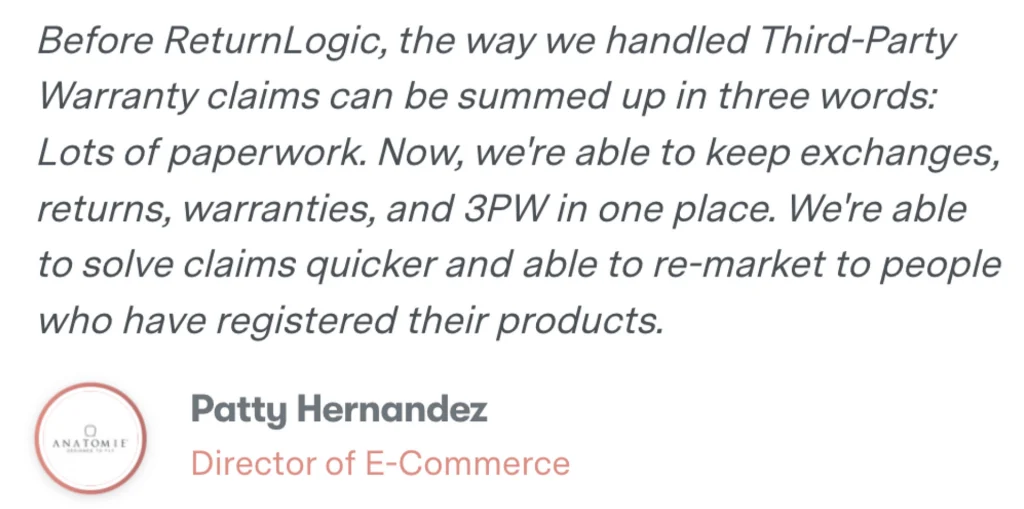
Patty is one of 100+ retailers who have made the switch to processing warranties as returns and never looked back.
Automating your warranty requests is a game-changer for ecommerce store owners.
The team saves time, the company makes money, and the customer stays happy.
Moving away from manually handling warranty requests is a win-win for everyone.
How to Use Warranty Data to Improve Your Business
In general, returns data is a treasure trove of information – the same holds true for warranty requests. By digging into return reasons, you can figure out if you have defective products, faulty packaging, or problems with your 3PL.
For example, if you notice an item keeps getting returned for damages, you could reach out to your manufacturer to check on the quality of the product. You could also try to improve your boxing and packaging. Lastly, you could decrease your ad spend on that item until you’re able to drop its return rate.
Or, if you notice your products are routinely getting lost, you can talk to your 3PL provider to figure out the cause and find a solution to prevent your brand from getting a reputation for poor shipping.
Without having data on warranty requests, you wouldn’t recognize these patterns to fix the problem.
Having warranty returns data helps you understand how your products are behaving in the market.
Essentially, what’s working and what’s not.
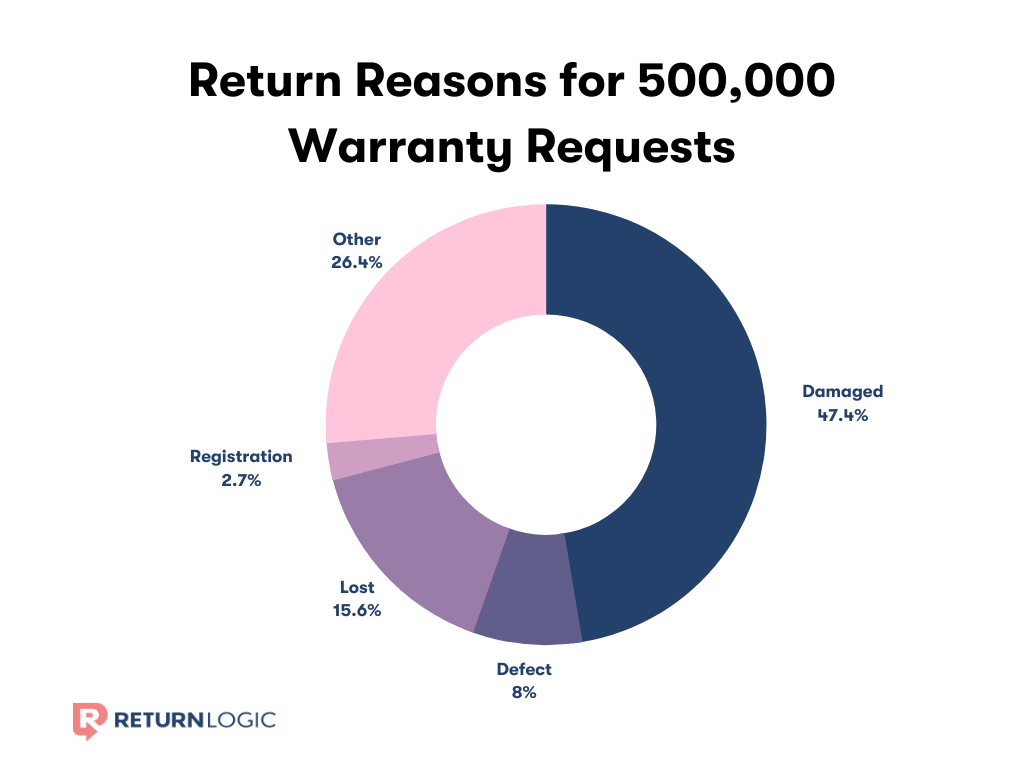
Image Source: ReturnLogic Internal Data
Another overlooked application of returns data is product registration to drive marketing strategies.
Any time a shopper registers a product with you, you’re able to create a new customer profile in your CRM.
Keeping track of each of your customer’s histories helps deepen customer relationships.
Having a record of who each customer is, how many times they’ve initiated a return with you, types and reasons for returns, and any additional notes left by your staff will help you segment your customers and personalize your marketing.
Showing your customers only what they’d be interested in makes it feel like your brand is trying to develop a relationship rather than constantly trying to sell a product.
This is big because nobody likes being sold to. With so much grabbing for your customers’ attention, anything that seems like a sales pitch automatically gets ignored.
When you make your customers feel like the promotions they get are handpicked for them, they start to pay more attention to what you have to say.
This drives repeat purchases which will ultimately improve your Customer Lifetime Value (CLV).
In today’s market, a brand’s biggest advantage is feeling genuine. Using returns data will help scale that genuine feeling without breaking the clock or the bank.
Conclusion
With a market as saturated as the ecommerce industry, trust can be a brand’s biggest competitive advantage.
At the end of the day, warranties show your customers that you believe in your products and that helps them trust their purchases.
Beyond that, warranty programs build customer loyalty, improve their overall experience, and ultimately increase your bottom line. That is, if they are managed correctly.
It’s time to make the switch to an automated warranty workflow.
With over 500,000 processed warranty RMAs and hundreds of workflows set up to date, we’re a team of experts. We can help.
To learn more about managing product warranties, check out our blog or schedule a time to talk to a representative today!


